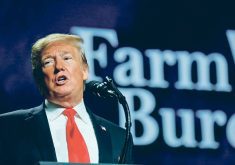Chicago | Reuters — U.S. Treasury Secretary Scott Bessent said on Thursday that China has agreed to buy 12 million metric tons of American soybeans during the current season through January and has committed to buying 25 million tons annually for the next three years as part of a larger trade agreement with Beijing.
Bessent said other countries in Southeast Asia have agreed to buy another 19 million tons of U.S. soybeans, but did not specify a timeframe for those purchases.
Read Also

U.S. grains: Soybeans hit six-week low as Brazilian harvest looms; corn, wheat sag
Chicago | Reuters – Chicago soybean futures fell to six-week lows on Friday as worries about slowing export demand for…
“So our great soybean farmers, who the Chinese used as political pawns – that’s off the table, and they should prosper in the years to come,” Bessent told Fox Business Network’s “Mornings with Maria” program.
The most-active soybean contract on the Chicago Board of Trade (CBOT) Sv1 reversed earlier losses and rose 1.35 per cent to $11.09-1/4 per bushel on Thursday after Bessent’s interview.
China diversifying soybean purchases
In 2024, the U.S. exported nearly 27 million tons of soybeans to China.
U.S. President Donald Trump wrote in a social media post overnight after a meeting with Xi Jinping in South Korea that the Chinese leader had authorized China to begin the purchase of massive amounts of soybeans, sorghum and other farm products.
U.S. Agriculture Secretary Brooke Rollins applauded Trump’s comments on soybeans and sorghum in a post on X.
But Even Rogers Pay, director at Beijing-based Trivium China, said the agreement effectively constitutes a return to business as usual in terms of U.S. soybean exports to China.
“It targets a level of trade that has been pretty consistent with the past few years,” she said.
Johnny Xiang, founder of Beijing-based AgRadar Consulting, said: “Commercial buyers are still waiting for more details — whether China will reduce the tariff on U.S. soybeans from 20 per cent to 10 per cent, or remove it entirely.”
“If the tariff is not completely lifted, commercial buyers will have little incentive to purchase U.S. soybeans,” he said.
Crops a bargaining chip
China, the world’s biggest soybean buyer and the top market for U.S. farmers, had turned its vast appetite for U.S. crops into a powerful trade war bargaining chip.
Facing import duties of 23 per cent on soybeans after rounds of tit-for-tat tariffs, Chinese buyers largely shunned the U.S. autumn harvest, turning instead to South American supplies.
The drop in Chinese demand has cost U.S. farmers – a key pillar of Trump’s political base – billions of dollars in lost sales.
Since the trade war of the first Trump administration, China has diversified its sources of soybean imports. In 2024, China bought roughly 20 per cent of its soybeans from the United States, down from 41 per cent in 2016, customs data shows.
— Reporting by David Lawder in Chicago; Andrea Shalal, Daniel Burns and Leah Douglas in Washington, Maiya Keidan in Toronto and Ella Cao in Beijing.















